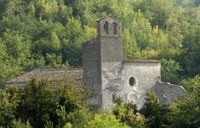Abbey of St John ad Insulam
The Abbey of St John ad Insulam is located in the deep countryside of the Sicilian Valley, at the foot of the Gran Sasso peaks. Its edifice is considered one of the main examples in Abruzzo of religious building in the Romanesque style. The church is also known as Saint John at Movone, from the same name of the river where it stands.
St John ad Insulam quietly waits for the visitors on top of the hill. The Benedictines of Montecassino who had settled down in all parts of the region, built it in 1150 to give the local community a new positive dimension of social, spiritual and cultural life. This new style of life had to replace the Saracen- Norman raids and the apocalyptical fears of the 11th century.
The plain and austere façade in square-cut stone and horizontal crowning presents an oxeye window, two double lancet windows on either side of the portal and decorative overhanging arched brackets running all along the external perimeter. This represents one of the oldest examples of this style that became popular in the 13th and 14th century.
The ground plan has three naves each divided in six arches on either side, with one semi-cylindrical apse at the end of the central nave.
The altar dominates the church’s interior, enhanced by the frescoed apsidal conch (a bowl-shaped apse) at the back, realized in 1421. This was attributed to a disciple of Andrea Delitio and depicts Christ inside an upright almond shape (mandorla) surrounded by the Madonna, Saint John the Baptist and Saint Giovannino. Unfortunately though the artwork is seriously damaged and only a careful restoration work could bring it back to its original beauty. The access to the crypt – perhaps built in the late 11th century - is through two lateral doors. The walled up external doorway endorses the theory that the crypt used to be the earliest basilica.
On the right-hand side of the façade, one finds the convent of which only few remains of the precinct wall are still visible. A fire or an earthquake maybe destroyed the building and wiped out most of the documents preserved inside the abbey.
In contrast, the church is well preserved because of the restoration works carried out over the years by the authorities of L’Aquila.
As a whole, the Abbey of St John ad Insulam looks bare. However, a second and more attentive look catches particulars that reveal fascinating and disturbing aspects of the medieval imagination, here symbolized by statues and paintings of great value.

















